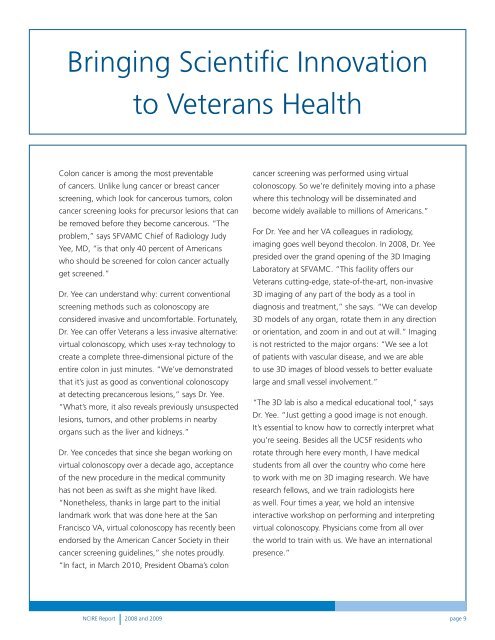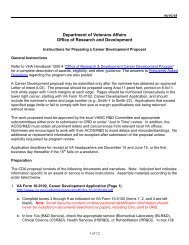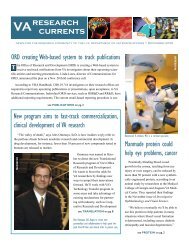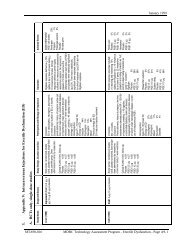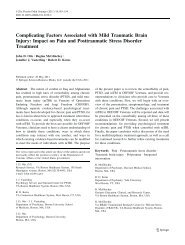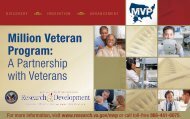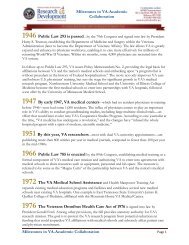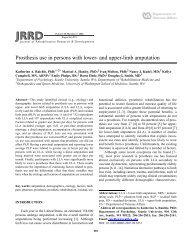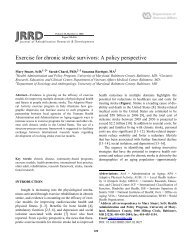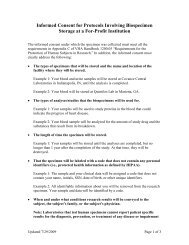commitment dedication collaboration - VHA Office of Research ...
commitment dedication collaboration - VHA Office of Research ...
commitment dedication collaboration - VHA Office of Research ...
Create successful ePaper yourself
Turn your PDF publications into a flip-book with our unique Google optimized e-Paper software.
Bringing Scientific Innovation<br />
to Veterans Health<br />
Colon cancer is among the most preventable<br />
<strong>of</strong> cancers. Unlike lung cancer or breast cancer<br />
screening, which look for cancerous tumors, colon<br />
cancer screening looks for precursor lesions that can<br />
be removed before they become cancerous. “The<br />
problem,” says SFVAMC Chief <strong>of</strong> Radiology Judy<br />
Yee, MD, “is that only 40 percent <strong>of</strong> Americans<br />
who should be screened for colon cancer actually<br />
get screened.”<br />
Dr. Yee can understand why: current conventional<br />
screening methods such as colonoscopy are<br />
considered invasive and uncomfortable. Fortunately,<br />
Dr. Yee can <strong>of</strong>fer Veterans a less invasive alternative:<br />
virtual colonoscopy, which uses x-ray technology to<br />
create a complete three-dimensional picture <strong>of</strong> the<br />
entire colon in just minutes. “We’ve demonstrated<br />
that it’s just as good as conventional colonoscopy<br />
at detecting precancerous lesions,” says Dr. Yee.<br />
“What’s more, it also reveals previously unsuspected<br />
lesions, tumors, and other problems in nearby<br />
organs such as the liver and kidneys.”<br />
Dr. Yee concedes that since she began working on<br />
virtual colonoscopy over a decade ago, acceptance<br />
<strong>of</strong> the new procedure in the medical community<br />
has not been as swift as she might have liked.<br />
“Nonetheless, thanks in large part to the initial<br />
landmark work that was done here at the San<br />
Francisco VA, virtual colonoscopy has recently been<br />
endorsed by the American Cancer Society in their<br />
cancer screening guidelines,” she notes proudly.<br />
“In fact, in March 2010, President Obama’s colon<br />
cancer screening was performed using virtual<br />
colonoscopy. So we’re definitely moving into a phase<br />
where this technology will be disseminated and<br />
become widely available to millions <strong>of</strong> Americans.”<br />
For Dr. Yee and her VA colleagues in radiology,<br />
imaging goes well beyond thecolon. In 2008, Dr. Yee<br />
presided over the grand opening <strong>of</strong> the 3D Imaging<br />
Laboratory at SFVAMC. “This facility <strong>of</strong>fers our<br />
Veterans cutting-edge, state-<strong>of</strong>-the-art, non-invasive<br />
3D imaging <strong>of</strong> any part <strong>of</strong> the body as a tool in<br />
diagnosis and treatment,” she says. “We can develop<br />
3D models <strong>of</strong> any organ, rotate them in any direction<br />
or orientation, and zoom in and out at will.” Imaging<br />
is not restricted to the major organs: “We see a lot<br />
<strong>of</strong> patients with vascular disease, and we are able<br />
to use 3D images <strong>of</strong> blood vessels to better evaluate<br />
large and small vessel involvement.”<br />
“The 3D lab is also a medical educational tool,” says<br />
Dr. Yee. “Just getting a good image is not enough.<br />
It’s essential to know how to correctly interpret what<br />
you’re seeing. Besides all the UCSF residents who<br />
rotate through here every month, I have medical<br />
students from all over the country who come here<br />
to work with me on 3D imaging research. We have<br />
research fellows, and we train radiologists here<br />
as well. Four times a year, we hold an intensive<br />
interactive workshop on performing and interpreting<br />
virtual colonoscopy. Physicians come from all over<br />
the world to train with us. We have an international<br />
presence.”<br />
NCIRE Report 2008 and 2009 page 9


